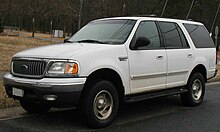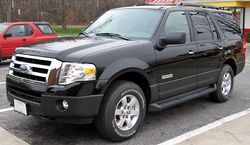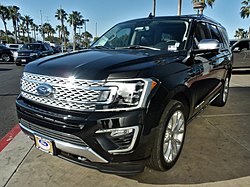Ford Expedition
| Ford Expedition | |
|---|---|
| Production period: | since 1996 |
| Class : | SUV |
| Body versions : | Station wagon |
| Previous model: | Ford Bronco |
The Ford Expedition is a full-size - SUV of the car maker Ford , mainly for the North American market. The vehicle replaced the Ford Bronco in autumn 1996 and was located in the model range between the smaller Ford Explorer and the Ford Excursion . Since production ended in May 2006, the Expedition has been the largest SUV in the Ford range.
In addition to the core market in the United States , Canada and Mexico , the model is also sold in Puerto Rico , American Samoa , the Northern Mariana Islands , the American Virgin Islands , Guam , the Philippines , the Middle East , Central America , the Caribbean , South America (with the exception of Argentina , Brazil and Venezuela ), Asia ( Cambodia , Laos , Mongolia and South Korea ), Africa ( Algeria , Angola , Cape Verde , Egypt , Gabon , Ghana , Libya , Madagascar , Morocco , Nigeria and Senegal ), and parts of Europe ( Armenia , Kazakhstan and Kyrgyzstan ).
For law enforcement agencies , fire brigades and rescue services , Ford offers a special version of the Expedition, the so-called Expedition Special Service Vehicle (SSV) , with cell phones , flashing lights and sirens .
Expedition (1996-2003)
| First generation | |
|---|---|
|
Ford Expedition (1996-1998) |
|
| Production period: | 1996-2002 |
| Body versions : | Station wagon |
| Engines: |
Petrol engines : 4.6-5.4 liters (160-194 kW) |
| Length: | 5197 mm |
| Width: | 1996 mm |
| Height: | 1887-1946 mm |
| Wheelbase : | 3023-3025 mm |
| Empty weight : | |
After 30 years, Ford stopped production of the three-door Ford Bronco and launched the Expedition, a five-door SUV as a successor, in autumn 1996. This was optionally available with a third row of seats and offered up to 9 seats. Together with its sister model, the Lincoln Navigator , the expedition rolled off the assembly line at the Bronco's production facility in Wayne , Michigan .
At the beginning of 1999 a slight facelift took place, similar to the tenth model generation of the Ford F-series , the car now had a lower grille and a new front bumper with integrated fog lights. In addition, the wheelbase changed from 3023 mm to 3025 mm.
The car had independent suspension on the front axle, a four-speed automatic and speed-dependent power steering. Due to its pulling power of around 3.7 tons, it was used particularly often as a towing vehicle. Two different V8 engines with a displacement of 4.6 liters and 5.4 liters, with an output of 160 kW (215 PS) and 172 kW (230 PS), were available. In 1999 the two engines were revised, they now developed 173 kW (232 PS) and 194 kW (260 PS).
ABS and airbags for the driver and front passenger were standard on the Expedition. From 2000, there were also side airbags for the front passengers at an additional cost, and from 2002 the car was equipped with a seat belt warning device for the driver's seat.
Expedition (2002-2007)
| Second generation | |
|---|---|
|
Ford Expedition (2002-2007) |
|
| Production period: | 2002-2007 |
| Body versions : | Station wagon |
| Engines: |
Petrol engines : 4.6-5.4 liters (173-223 kW) |
| Length: | 5227 mm |
| Width: | 1999 mm |
| Height: | 1946-1971 mm |
| Wheelbase : | 3023 mm |
| Empty weight : | |
The second generation of models appeared at the end of 2002. The most important technical innovation was the rear independent suspension. The Expedition was the first full-size SUV with this design. Steering, braking and electronic systems have been revised. The third row of seats, which was optional in the first generation, was now standard. However, this could now be folded over and sunk into the floor, even electrically for an additional charge.
The engines available were initially identical to those of the first generation. In 2005 they were replaced by a new 5.4-liter V8 engine with three-valve technology and variable camshaft control , which developed 223 kW (300 hp). This engine was also only available with a four-speed automatic transmission, which, however, was newly developed and carried out the gear change electronically. The pulling force increased to 4037 kg.
Expedition (2007-2017)
| Third generation | |
|---|---|
|
2007 Ford Expedition |
|
| Production period: | 2007-2017 |
| Body versions : | Station wagon |
| Engines: |
Petrol engines : 3.5–5.4 liters (223–272 kW) |
| Length: | 5232-5621 mm |
| Width: | 2002 mm |
| Height: | 1961-1989 mm |
| Wheelbase : | 3023-3327 mm |
| Empty weight : | 2626 kg |
At the Houston Auto Show 2006 Ford presented the third generation of the Ford Expedition. In spring 2007 this came on the market.
The front section has been completely redesigned and, with the wide chrome struts, is now closely aligned with the current generation of the F series.
In the interior, a new dashboard and a new center console were installed, these are also based on the F-series. The car has, among other things, a three-zone automatic air conditioning, ABS and six airbags as standard.
The third generation was initially powered by the same engine as the previous model, but equipped with a new 6-speed automatic transmission. In 2009 the engine was revised to meet the demands for more environmentally friendly vehicles, since then it can also be operated with ethanol fuel E85. For the 2015 model year, the 5.4-liter V8 petrol engine was replaced by a 3.5-liter V6 petrol engine.
Since 2009 the expedition, like its sister model Lincoln Navigator , has been built in Louisville (Kentucky) - instead of in Wayne as before. The third model generation of the Ford Focus has been produced here since then .
Expedition EL
With the additional version EL, which has been available since 2007, Ford closes the gap that had arisen since the Ford Excursion was discontinued in spring 2006. The Expedition EL is a 38 cm longer version of the Ford Expedition. Technically, this version is identical to the Expedition.
In Canada and Mexico, the model is offered as Expedition Max , since Honda already offered a model of the same name in Canada from 1996 to 2005 with the Acura EL .
Technical specifications
| 3.5 V6 Ecoboost | |
|---|---|
| Construction period | 2015-2017 |
| Engine characteristics | |
| Engine type | V6 petrol engine |
| Displacement | 3496 cc |
| Compression ratio | 10.0: 1 |
| Max. Power at min −1 | 272 kW (370 hp) / 5000 |
| Max. Torque in min -1 | 570 Nm / 2500 |
| Power transmission | |
| drive | all wheel drive |
| Gearbox, as standard | 6-speed automatic transmission |
| Readings | |
| Top speed | 182 km / h |
| Acceleration, 0-100 km / h | 6.4 s |
| Fuel consumption over 100 km | 14.7 l super |
| Tank capacity | 87 l |
U553 (since 2017)
| U553 | |
|---|---|
| Production period: | since 2017 |
| Body versions : | Station wagon |
| Engines: |
Gasoline engines : 3.5 liters (298 kW) |
| Length: | 5334-5636 mm |
| Width: | 2029 mm |
| Height: | 1935-1946 mm |
| Wheelbase : | 3112-3343 mm |
| Empty weight : | |
The fourth generation of the Expedition was presented at the Chicago Auto Show in February 2017 and has been built in Louisville since September 25, 2017 . The long version is now called Expedition MAX. For the first time, the SUV is based on an aluminum body. The only drive option available is a 298 kW (405 hp) 3.5-liter V6 petrol engine.
Technical specifications
| 3.5 V6 Ecoboost Ti-VCT | |
|---|---|
| Construction period | since 09/2017 |
| Engine characteristics | |
| Engine type | V6 petrol engine |
| Displacement | 3496 cc |
| Compression ratio | 10.0: 1 |
| Max. Power at min −1 | 298 kW (405 PS) / 5000 |
| Max. Torque in min -1 | 637 Nm / 3500 |
| Power transmission | |
| Drive, as standard | Rear wheel drive |
| Drive, optional | ( Four-wheel drive ) |
| Gearbox, as standard | 10-speed automatic transmission |
| Readings | |
| Top speed | 193 km / h |
| Acceleration, 0-100 km / h | 6.6 s |
| Fuel consumption over 100 km | 11.8–12.4 l super (12.4–13.1 l super) |
| Tank capacity | 88 l |
Web links
- Official manufacturer website (English)
Individual evidence
- ↑ Extremely large and variable. auto-motor-und-sport.de, February 8, 2017, accessed on January 23, 2018 .








